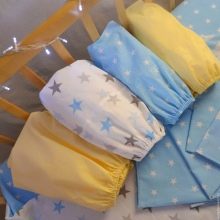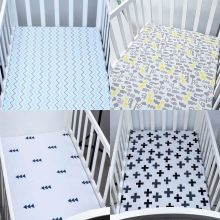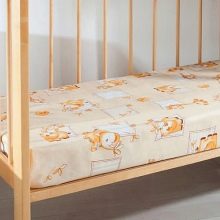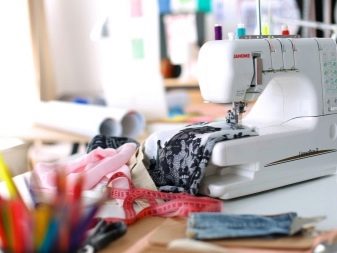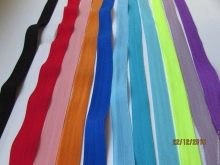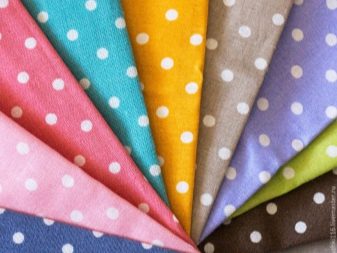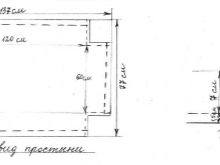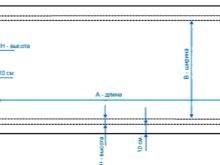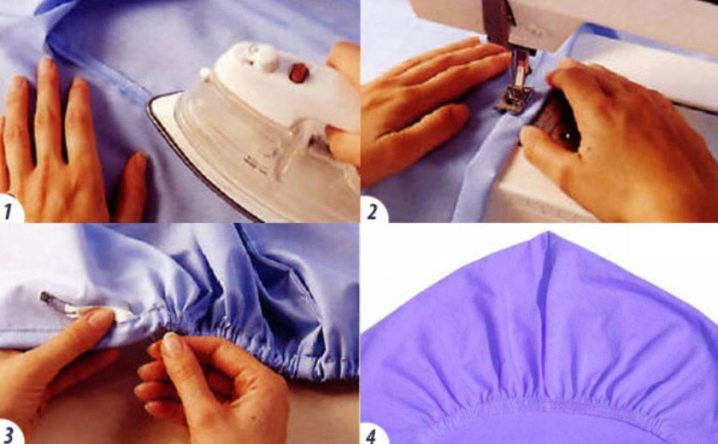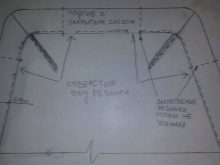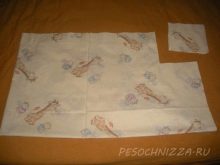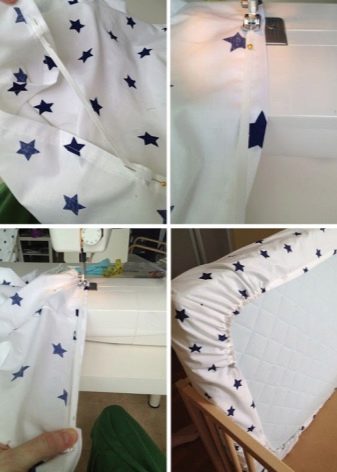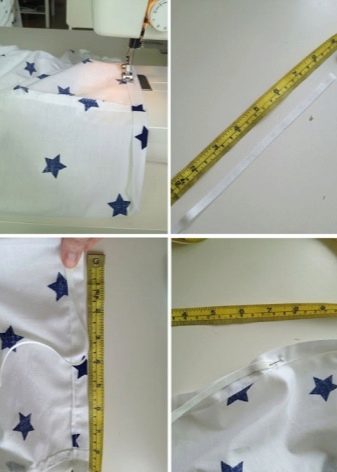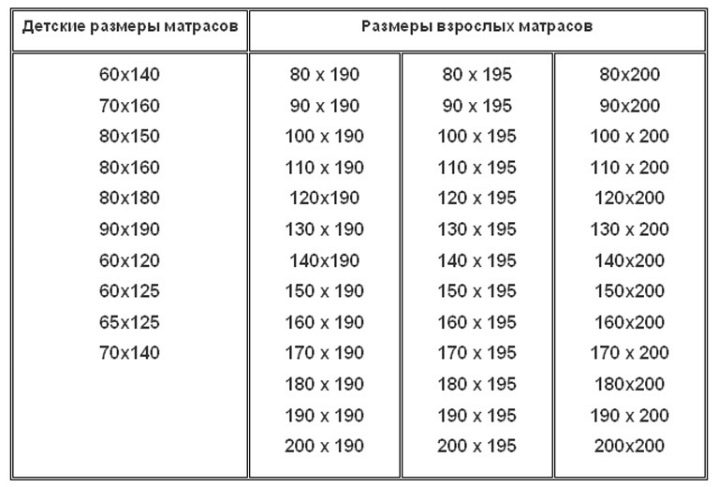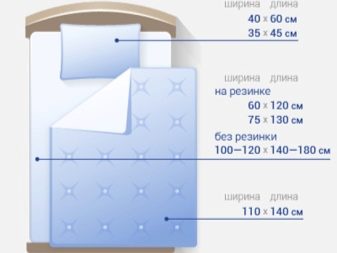How to sew a sheet on an elastic band in a crib with your own hands?
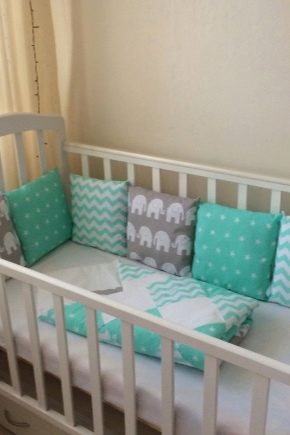
Sleep is an essential part of our life. On how comfortable we are in bed, and our mood, and the quality of sleep. Children in a dream are very active, often turning over, waving their arms and legs, so often the edges of the bedding are knocked out and form a lump. The solution to this problem can serve as a sheet with elastic in the crib.
The choice of fabric
Sheets on an elastic band are firmly fixed in the life of a modern person due to the fact that they are very convenient to use. It is also convenient to use these sheets in the event that the shape of the bed is round, since the standard options are not quite suitable.
Sewing sheets with your own hands will take a little time, but it can significantly save the family budget. You will need the following accessories for this:
- pins;
- scissors;
- sewing machine;
- the cloth;
- threads;
- clothes elastic;
- edging tape;
- iron.
Fabric can be selected according to the preferences of the owners: colored or monochromatic, terry or knitted.
Cotton fabrics are natural, hypoallergenic, breathable and safe for babies. Bamboo fiber has antimicrobial and anti-mite properties, as well as high absorbency. Chintz is one of the most affordable materials, but wears quickly. Percals and calico have a high density - the shape of such products does not change during use or washing.
The flannel is pleasant to the skin due to its softness, but it can settle when used. Satin does not crumple and has high wear resistance. Knitted fabrics can quickly lose color (to avoid such a result, you should carefully examine the composition of the fabric you liked and take into account the manufacturer's recommendations on the temperature mode of washing products made of such fabric) and stretch out, but note the softness and comfort of such products.
What to look for?
The main indicators that are recommended to pay attention when choosing the most comfortable fabric, are the positions described below.
- Composition. The study of the components will allow you to understand how many natural, artificial or synthetic fibers in the material. A large percentage of natural fiber increases the value of the product. The use of predominantly natural fabrics is recommended, because they are valued much more synthetic because of their environmental friendliness, but may vary in their durability.
- Quality. Its indicators include the strength and durability of fabrics. Attention should also be paid to the color and method of processing materials, because manufacturers often neglect the technological process, thereby saving time for the production of fabrics. To find out how good dyes were painted, you can take the chosen fabric and rub it between your palms, then see if there are traces of dyes on your hands.
- The density of the fabric. It happens in all materials different - it can be seen on the packaging. The manufacturer specifies the composition and density of the fabric.
- Price must comply with the quality of the drawings made on fabric and color.
- Linen should be environmentally friendly, safe, not provoke the occurrence of an allergic reaction when in contact with the body. It should have good absorbing properties and breathability allowing the skin to receive and release oxygen.
- If you need to make clothes for the childthen it is necessary to take into account the possible time for its washing; so that the laundry is well washed, as often small children defecate on it. Also, it should dry quickly, iron iron without additional effort.
How to sew?
Below is a step-by-step version of tailoring sheets from the flannel, because it is especially comfortable for the delicate skin of the baby.
The size of the mattress of the children's bed is 60x120 cm, the width of the flannel is 90 cm. In this case, you will need a length of 1.5 m.
In order to avoid possible shrinkage problems, you can wash the fabric before sewing. Shrinkage is calculated as follows:
- it is necessary to take a piece of fabric 1x1 m;
- wash it in the same way that you plan to wash clothes;
- dry the material, iron carefully;
- after the procedures performed, it is possible to calculate how many times the segment has sat down: shrinkage = 100 - (d2x100 / d1).
That is, if before washing it was 100 cm, and after washing it was 98 cm, then shrinkage = 100 - (98x100 / 100) = 2%.
Then you need to measure the fabric in accordance with the possible shrinkage. After that, in the corners of the resulting rectangle, you need to cut the squares - you can make the cardboard blanks in the form of squares for further use 15-17 cm wide.
After the shapes are cut, the inner edges of the squares need to be stitched together — in this way, a kind of envelope will be obtained. Then you need to overlay the edges of the fabric or hem the edging tape (this method is more interesting because of its aesthetics).
In order to sew gum, you need four such segments, one for each side. The length of each cut of the gum should be 25 cm. At the edges of the sheet you need to mark out each corner of 20 cm in both directions. Stretched gum must be pinned with pins so that the middle of the gum is adjacent to the corner seams. It is possible for convenience with the iron to iron the bends for the gum around the perimeter of the sheet.
Then you should flash it all with a zigzag: the larger the zigzag, the better.
There are also other ways of stitching gum sheets. For example, when not the entire perimeter of the product is stitched, but only two opposite sides. In this case, you need to correctly calculate the meter of the elastic band so that the product fits snugly on the mattress (mattress pad) on all sides.
After the work done on the resulting oval case tied all the nodules. Children's single bed sheet is ready, you can try it on the mattress.
By the same principle, you can sew sheets of other sizes, regardless of the size of the bed. If the size of the fabric does not match the width of the mattress, the height of the sides, then you can hem the sides separately.
The pattern is pretty simple. The main thing is to buy the required amount of fabric. To do this, measure the length and width of the mattress, as well as the height of the sides. On average, it is about 15-20 cm.
Then you should draw a rectangle on the fabric. The width of one side is equal to the length of the mattress and the height of the two sides. That is, if the height of the side of the mattress is 20 cm, then you need to take 40 cm. Add another 30 cm to the first side and make the appropriate markup.
The other side of the mattress is equal to the width of the mattress, the height of the two sides, but you need to add another 20 cm.
After that, the resulting rectangle must cut corners in the form of squares with a side of 15 + 10 cm.
For sewing waterproof sheets you will need a raincoat from which raincoats and waterproof suits are sewn. It is also possible to use cloth oilcloth. You need to take the required size of waterproof fabric and hem it around the perimeter of the rectangle at the stage when the pattern is made from the main fabric. You can fasten the fabric by longitudinal and transverse sewing with a sheet - so it can last longer and will not lose its appearance when machine-washed. Using a waterproof fabric, you can easily avoid contamination of the mattress (mattress pad) in the case of stool baby.
Dimensions
It is important to carefully measure the dimensions of the mattress before purchasing the fabric, as the dimensions may vary slightly depending on the manufacturer. Mattresses for children come in the following sizes: 60x120, 60 by 190, 60 by 195, 60 by 200, 65 by 125, 65 by 190, 65 by 195, 65 by 200, 70 by 140, 70x160, 70 by 190, 70 by 195 , 70 by 200, 75 by 190, 75 by 200 and 80x160 cm.
The sizes of the single variants: 80 by 190, 80 by 195, 80 by 200, 85 by 190, 85 by 195, 85 by 200, 90 by 190, 90 by 195, 90 by 200, 95 by 190, 95 by 195 and 90 by 200 cm
When choosing a set of bed linen should also take into account possible variations in size in proportion to the age category of the child.
For children of preschool and primary school age, the dimensions should be 120 by 60 or 125x65 cm, for children of school age 6-7 years old and more - 160x80 and 160x70 cm. As for older children, there are a few more options: 90x200, 80x190, 200x80 and 80x180 cm
Also, before buying and cutting fabric, you should not forget about the consumption of fabric for the height of the sides and for overlaying the material. Careful selection of the texture and size of the fabric will allow the child to enjoy a peaceful sleep.
How to calculate?
You can apply the following formula to calculate the fabric for sewing sheets, where A is the width of the mattress, B is its length, and C is the thickness.
The width of the sheet is calculated as follows:
W = A + 2xC + 2x2 cm + 2x6 cm (for seams and seam allowance).
Sheet length:
D = B + 2xC + 2x2 cm + 2x6 cm (for seams and seam allowance).
After carrying out the necessary calculations, a rectangle should be cut out on the fabric with sides equal to Ш and D.
How to sew a sheet on an elastic band in a crib, see in the video below.
